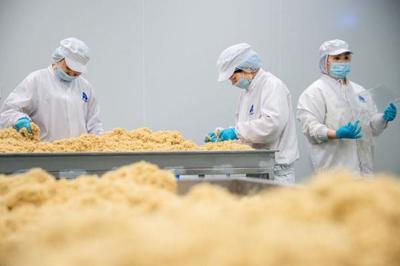Application field impact-aperture
► Food and Beverage Industry
 -Impact scenario:
-Impact scenario:
-Liquid filtration (such as alcohol, juice, syrup): Deviation in pore size may result in residual impurities (such as meat particles, microorganisms), affecting product clarity and shelf life.
-Particle screening (such as flour, milk powder, seasoning): Insufficient precision can lead to uneven particle size in the product (such as flour roughness not meeting standards), affecting the processing technology (such as the taste of baked products).
-Standard requirements: It must comply with food grade hygiene standards (such as FDA, GB 14936), and the aperture error must be controlled within ± 5%.
► Pharmaceutical and Biopharmaceutical Industry
 -Impact scenario:
-Impact scenario:
-Drug production (such as tablet and capsule raw material screening): The pore size accuracy determines the particle size distribution of drug particles (such as API raw material particle size), directly affecting the speed and uniformity of drug efficacy release.
-Aseptic filtration (such as injection solutions and eye drops): The micron sized pore size needs to be accurately matched to the bacterial interception requirements (such as 0.22 μ m filter membrane used for sterilization), as a large pore size may lead to microbial contamination.
-Standard requirements: It must comply with GMP specifications, with aperture tolerances typically ≤ ± 2%, and must pass integrity testing (such as bubble point detection).
► Electronics and Semiconductor Industry
 -Impact scenario:
-Impact scenario:
-High purity material screening (such as silicon powder, photoresist raw materials): Aperture errors may introduce impurity particles (such as metal debris), leading to short circuits or defects in the chip manufacturing process.
-Electronic slurry filtration (such as PCB circuit board ink): Insufficient aperture accuracy can cause slurry particles to agglomerate, affecting the resolution and conductivity of printed circuits.
-Standard requirements: The aperture tolerance should be controlled within ± 1 μ m, and the screen mesh should have anti-static properties to avoid particle adsorption affecting accuracy.
► Chemical and petroleum industries
 -Impact scenario:
-Impact scenario:
-Catalyst separation and recovery: High precision pore size ensures effective retention of catalyst particles (such as nanoscale precious metals), avoiding waste or equipment blockage.
-Oilfield solid-liquid separation (such as drilling fluid filtration): Deviation in pore size may result in residual drilling cuttings, affecting drilling efficiency or causing equipment wear.
-Key data: In the fine chemical filtration scenario, the aperture accuracy needs to reach ± 3%, and in high-temperature environments (such as oil refining), it is also necessary to combine material heat resistance (such as 310S stainless steel).
► Aerospace and Precision Machinery
 -Impact scenario:
-Impact scenario:
-Fuel system filtration (such as aviation fuel, hydraulic oil): Micro sized pores need to accurately intercept impurities (such as metal particles, gel like substances) to avoid nozzle blockage or mechanical failure.
-Air purification system: The aperture accuracy affects the filtration efficiency of particulate matter (such as PM2.5, sand and dust), which is related to the safety of the cabin environment.
-Standard requirements: Must be certified according to aviation industry standards (such as SAE AS4059), with an aperture error of ≤ ± 1.5%, and must withstand high voltage and high vibration environments.
► Nanomaterials and Research Fields
 -Impact scenario:
-Impact scenario:
-Preparation of nanoparticles (such as carbon nanotubes and quantum dots): The pore size accuracy determines the uniformity of the particle size distribution of nanomaterials, directly affecting material properties (such as optical and electrical properties).
-Laboratory separation (such as cell screening, DNA purification): The micrometer scale pore size needs to match the size of the target substance (such as mammalian cell diameter 10-30 μ m), and errors may lead to experimental result bias.
-Technical difficulty: It is necessary to use electron microscopy level detection methods (such as scanning electron microscopy) to verify the aperture accuracy, with tolerances often controlled within ± 0.5 μ m.
► Summary: The core influencing dimension of aperture accuracy
 1. Product quality: directly determines key indicators such as material purity and particle size uniformity.
1. Product quality: directly determines key indicators such as material purity and particle size uniformity.
2. Production efficiency: Insufficient accuracy may lead to equipment blockage, increased energy consumption, or an increase in rework rate.
3. Compliance: Industries such as food, medicine, and aviation must strictly comply with regulatory standards, and aperture accuracy is one of the core quality inspection items.
4. Cost control: The initial cost of high-precision screen mesh is relatively high, but it can reduce raw material waste and equipment maintenance costs, with significant long-term benefits.
Selection suggestion: It is necessary to match the screen manufacturing process according to industry characteristics (such as electro etching, laser cutting, etc.), and verify the aperture accuracy through sampling testing (such as microscope measurement, screening efficiency testing).







